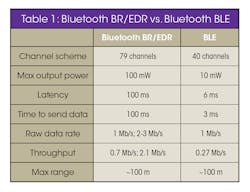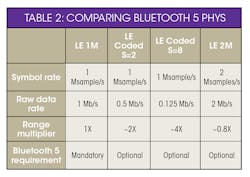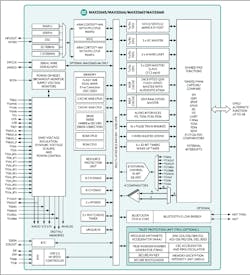Download this article in PDF format.
Wireless communication is becoming integral to electronics as more and more consumers demand the ability to send and receive data without being tied down with plugs and cables. Among the most popular wireless communication protocols is Bluetooth, which has the versatility to find homes in a range of applications.
Among many other apps, Bluetooth is embedded in cars so that users can play their favorite music from a smartphone on the car stereo. The new field of smart-home security utilizes Bluetooth to allow individuals to perform tasks like locking and unlocking their front door with their phone. Bluetooth can also be used to send files between a tablet and a computer, send updates from a fitness tracker to a computer or phone, and much more. Figure 1 depicts two common Bluetooth-enabled devices, a smartphone and a laptop.
1. Thanks to the Bluetooth protocol, we can send and receive data without the tangle of cords and wires.
All of these different applications fall under the blanket term “Bluetooth,” but, surprisingly, not all of them use the same wireless protocols. Some employ Bluetooth Low Energy (BLE), while others employ Bluetooth Basic Rate/Enhanced Data Rate (Bluetooth BR/EDR). Newer applications even have the potential to use Bluetooth 5.
Most people don’t know the difference between Bluetooth BR/EDR and BLE, nor which of the two is best suited for their specific applications. Things have gotten more confusing with the introduction of Bluetooth 5, which blurs the line between these protocols even more. This article aims to explain where BLE differs from Bluetooth BR/EDR and how Bluetooth 5 promises to enhance both protocols. It will also help you to determine the version that’s most appropriate for your application.
History
To better understand how Bluetooth BR/EDR and BLE differ, it’s important to examine the history of these wireless technologies. Each of them was developed by the Bluetooth Special Interest Group (Bluetooth SIG), which manages all Bluetooth protocols. As developments are made, the Bluetooth SIG releases a new specification to introduce improvements. The timeline in Figure 2 shows the Bluetooth specifications that have been released and where Bluetooth BR, Bluetooth EDR, BLE, and Bluetooth 5 fall within those specifications.
2. The timeline shows each Bluetooth specification release throughout the years.
Bluetooth BR/EDR
Bluetooth BR was the first Bluetooth protocol developed. It implemented a unique method of using Gaussian frequency-shift keying (GFSK) to exchange data within the 2.4-GHz ISM band. This band was chosen because, unlike most frequency bands, a license isn’t required to operate within it, so communication is free. Bluetooth BR quickly become popular because it provided a low-cost and low-power way to send and receive data wirelessly across short ranges at data rates up to 0.7 Mb/s.
A few years later, a new specification, Bluetooth 2.0, was released that included the option for Bluetooth EDR. Bluetooth EDR allows data to be transferred two to three times faster than Bluetooth BR. That’s because it employs differential quadrature phase-shift keying (QDPSK) and differential 8-level phase-shift keying (8DPSK) alongside GFSK. GFSK transmits one bit per symbol, whereas QDPSK transmits two bits per symbol and 8DPSK transmits three bits per symbol.
BLE
When BLE was first developed, it was, in fact, not even Bluetooth at all! It was developed by Nokia as a wireless technology called Wibree. It was designed to consume very little power (as well as be very low cost and easy to configure), making it the perfect solution for devices that run on small batteries.
Wibree included many techniques similar to Bluetooth BR/EDR, including operation in the 2.4-GHz ISM band, GFSK modulation, a channel scheme, and frequency hopping. The parallels between the two caused the Bluetooth SIG to adopt Wibree into its specification. It was released as a new low-energy extension called Bluetooth Low Energy (BLE). BLE made its first appearance in the specification Bluetooth 4.0.
Bluetooth 4.0 did not completely obsolete Bluetooth BR/EDR, but instead offered BLE in addition to Bluetooth BR/EDR. Consumer devices with BLE were often labeled as being Bluetooth Smart, whereas Bluetooth BR/EDR are labeled as Bluetooth Classic; however, these terms are no longer used to differentiate each protocol. Under this specification, radios could be developed to operate as a Bluetooth BD/EDR-only radio, a BLE-only radio, or a dual radio that supports both Bluetooth BR/EDR and BLE.
Bluetooth 5
Bluetooth SIG does its best to make improvements that match the evolution of technology, and one of the key advances that seems to be driving electronics is the Internet of Things (IoT). BLE has played a big role in growing IoT, but the Bluetooth SIG wanted to further enhance the capabilities of Bluetooth in IoT applications. The new advances to the original BLE technology were released in Bluetooth 5.0, which is being termed Bluetooth 5.
Bluetooth BR/EDR vs. BLE
Let’s compare the similarities and differences between just Bluetooth BR/EDR and BLE. A good place to start is in the physical layer (PHY) of the protocols. The PHY contains the circuity used to modulate and demodulate analog signals and turn them into digital symbols. The differences in the PHY is one of the factors that makes each protocol geared toward specific applications. Four areas of the PHY where BR/EDR and BLE differ are the channel scheme, power consumption, latency, and throughput.
Channel Scheme
Both Bluetooth BR/EDR and BLE communicate in the 2.4-GHz ISM band, but they differ in the number of channels in which they divide the frequency band. Bluetooth BR/EDR divides the band into 79 channels spaced 1 MHz apart. BLE employs a simpler transmitter and receiver, so it divides the band into only 40 channels spaced 2 MHz apart.
One thing that both Bluetooth BR/EDR and BLE must deal with, regardless of the number of channels used, is interference. The 2.4-GHz ISM band is full of transmitters taking full advantage of the unlicensed band. To minimize interference, both Bluetooth BR/EDR and BLE employ frequency hopping where the radio operates on one channel for a brief period of time before hopping to another channel to continue communication.
BLE also adds another element to its channel scheme. BLE reserves three channels for a BLE radio to advertise that it wants to be discovered. The frequency of these three advertising channels were strategically chosen so that they didn’t interfere with the three most frequently used Wi-Fi channels also operating in the 2.4-GHz ISM band. Once a connection is made, the radios will continue their communication on one of the other 37 channels. Figure 3 depicts the channel scheme for BLE and shows where the three advertising channels are located within the frequency band.
3. This is the channel scheme for BLE.
Power
Conservation of energy is a key differentiator between Bluetooth BR/EDR and BLE—made obvious by the fact that BLE has “low energy” in its name! Bluetooth BR/EDR uses a maximum output power of 100 mW to transmit data up to approximately 10 to 100 m. This was fine in the days where most devices could be charged frequently. However, as the demand of products that can run off battery power for months or years without being charged increases, this type of output power will not suffice as it would quickly drain the battery.
BLE offers the perfect solution. It reduces the energy by only turning on the transmitter and receiver when they’re needed to send or receive data, with a maximum power output of only 10 mW to transmit up to the same range. BLE also sends data in short bursts of packets. When packets aren’t being sent, the radio sits idle, drawing little to no power. This process helps BLE live up to its name.
Latency
Another way BLE outperforms Bluetooth BR/EDR is in latency. It takes Bluetooth BR/EDR approximately 100 ms to be ready to send data. There’s an additional 100-ms latency from when data is received at the transmitter to when it’s available at the receiver. This can make for a rather noticeable delay in some cases. It also leads to higher power consumption because the extra time required to send data causes more energy from the battery to be used.
BLE offers much lower latency. It only takes 3 ms for BLE to be ready to send data. Also, the latency from when data is received at the transmitter to when it’s available at the receiver is only 6 ms. This allows data to be sent more quickly and saves power.
Throughput
At this point, you might be wondering why anyone would chose Bluetooth BR/EDR over BLE. Well, where BLE lags behind Bluetooth BR/EDR is in throughput. Both Bluetooth BR/EDR and BLE employ GFSK, so theroetically, the maximum limit for the throughput is 1 Mb/s. However, factors such as protocol overhead, radio limitiations, and artifical software restrictions limit the actual throughput.
In practice, Bluetooth BR can reach a throughput up to 0.7 Mb/s, while Bluetooth EDR can achieve a throughput of 2.1 Mb/s. This is enough throughput for applications like streaming audio. Because BLE sends data in short bursts to conserve power, its throughput faces additional restrictions. It can only achieve a maximum throughput of 0.27 Mb/s. While this throughput isn’t enough for streaming audio, it’s more than enough to send sensor data that don’t need to be transmitted constantly.
Through these four sections, it’s clear that differences in the PHYs for each of these protocols causes a lot of differences in the operating parameters. Table 1 summarizes the key parameters between Bluetooth BR/EDR and BLE.
BLE 5.0
Bluetooth 5 uses the original low-power BLE technology but includes some new enhancements. One of the biggest enhancements is the introduction of three PHYs that can be selected to improve the maximum range or throughput. Bluetooth 5 also adds enhancements that improve advertising.
The first PHY that Bluetooth 5 offers is called LE 1M. This is the same PHY used for BLE in the Bluetooth 4.2 specification, so most of its parameters will match those shown in Table 1. LE 1M is the only PHY that’s mandatory in Bluetooth 5. The other two PHYs are optional.
Bluetooth 5 integrates a coded PHY as one of the optional PHYs, which can extend the range of communication. The coded PHY achieves longer range by introducing redundancy to get some processing gain, instead of increasing the power of the transmitter.
Bluetooth 5 introduces additional redundant bits that are used to determine the correct value of a bit. The coded PHY comes in two variations: S=2 and S=8. S=2 sends two symbols per bit, which decreases the throughput by a factor of two, but theoretically doubles the range. S=8 sends eight symbols per bit. Though this decreases the raw throughput to 125 kb/s, it approximately quadruples the range. In practice, the actual range will be a little lower than the theoretical values, but this method still helps to achieve a much larger range.
Range isn’t important to all end applications, so Bluetooth 5 made sure to include something for applications where throughput is more important than range. There’s a double-data-rate option called LE 2M, which increases the raw data rate to 2 Mb/s. It allows for data to be sent at a maximum actual throughput of 1.4 Mb/s. This means that data can be transferred even faster than Bluetooth BR with a lower power consumption.
Table 2 compares the three PHYs available in Bluetooth 5 to show how they differ in terms of raw data rate and range.
Bluetooth 5 offers a lot of enhancements to advertising. It still utilizes the same channel scheme as BLE, but includes options for additional advertising on all 40 channels instead of just three. In Bluetooth 5, small advertising packets can be transmitted on the three advertising channels used in BLE. However, they can now point to larger advertising packets (up to 255 octets) that can be sent on the additional 37 channels. This also helps reduce the amount of content on the three primary advertising channels. Bluetooth 5 also includes enhancements for advertising packet chaining, periodic advertising, and a lower minimum advertising interval.
Applications
The differences in the PHY are key to determining which protocol best suits each application. We’ve covered many technical details in the last few sections that can be applied to better understand the ideal use of each protocol.
Let’s start with Bluetooth BR/EDR. It compromises packet latency and power for a higher throughput rate, so it is best suited for applications where throughput is a critical specification. This makes it the ideal protocol for applications like streaming or sending large amounts of data. Common applications are wireless headsets (Fig. 4) and point-to-point applications.
4. Wireless headsets represent one example of a common application for Bluetooth BR/EDR.
BLE is best suited for applications that only need to send small amounts of data whereby the device can wake up, transmit the data it needs to, and then go back to sleep. BLE’s low power consumption makes it a must for devices that are powered from a small battery. An application that’s well-suited for BLE is a heart-rate monitor. The heart-rate monitor doesn’t need to send data often, but it does need to run for an extended period on a battery. As the field of IoT continues to develop, we will likely see many new applications of BLE.
It’s important to note that when you’re choosing a Bluetooth-enabled device for your application, you need to be sure you select an IC that supports the protocol you plan to use. You can’t buy an IC at random and assume it supports both Bluetooth BR/EDR and BLE. As mentioned before, Bluetooth BR/EDR and BLE use different PHYs, so you will need to be sure the IC you select supports the PHY for the protocol you plan to use, or it supports both PHYs if you believe both could be beneficial in your application.
Bluetooth 5, which promises extensive improvements, has begun to appear in popular technologies. Many popular smartphones are already offering Bluetooth 5 support. As with most wireless protocols, it has taken a few years for Bluetooth 5 to be integrated into most electronics. However, it’s becoming evident that the time for Bluetooth 5 is now.
If you want to be ready for Bluetooth 5, a Bluetooth 5-compatible microcontroller is needed to address the key requirements. One example is Maxim’s MAX32666GWPBT, which has dual Arm Cortex-M4 cores and separate hardware dedicated to running the Bluetooth stack (Fig. 5). This leaves the two cores entirely free for your application. Another option is the MAX32665 low-power Arm Cortex-M4 with floating-point unit (FPU) microcontroller with Bluetooth 5. This microcontroller includes power-management features such as a single-inductor multiple-output (SIMO) switched-mode power supply and dynamic voltage scaling to minimize power consumption, and thus is well-suited for battery-operated systems.
5. The MAX32666GWPBT microcontroller targets Bluetooth 5 applications.
Conclusion
As with any good lesson, the best way to test your knowledge is with a quiz. Challenge yourself to go back to the applications listed in the beginning of this article and see if you can determine which Bluetooth protocol each one uses. If you get stuck, the answers are below…
Bluetooth BR/EDR is good for applications where the maximum throughput is critical. It can consume a significant amount of power, so it’s not good for applications that require extended battery life. It also has greater latency and takes longer to set up the connection to send data. Consequently, it’s not meant for applications that transmit and receive infrequent, short messages. You can find it used to connect a phone to a car stereo to play music or send files between computers or tablets. Both applications require high throughput and can afford to consume some power.
BLE is used when low power consumption is critical and high throughput isn’t required. It can send data very quickly and has a low latency. You will find it used in applications that need to run for a long time on a small battery or those that don’t need to send data often. BLE is used in home security systems like smart door locks and in fitness trackers.
Even though these technologies are all called Bluetooth, they truly offer different strengths to the world of wireless electronics. To determine which protocol is best suited for your applications, make sure to look back at the differences in the PHY listed in Table 1 to see where each protocol excels. Also, be on the lookout for how Bluetooth 5 will change the industry in the next few years with its higher throughput, longer range, and extended advertising capabilities.
Samantha Morehead joined Maxim Integrated as an Associate Member of Technical Staff.


















